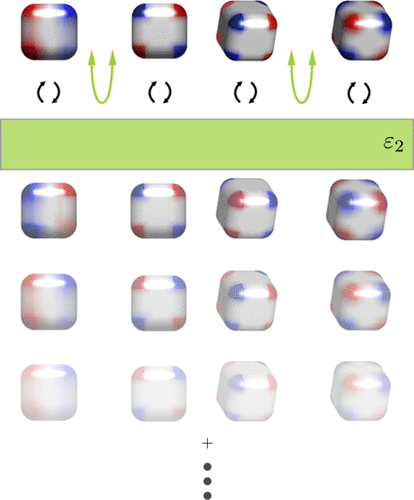当前位置:
X-MOL 学术
›
J. Phys. Chem. Lett.
›
论文详情
Our official English website, www.x-mol.net, welcomes your
feedback! (Note: you will need to create a separate account there.)
Multipolar Nanocube Plasmon Mode-Mixing in Finite Substrates
The Journal of Physical Chemistry Letters ( IF 4.8 ) Pub Date : 2018-01-16 00:00:00 , DOI: 10.1021/acs.jpclett.7b03271 Charles Cherqui 1 , Guoliang Li 2 , Jacob A. Busche 1 , Steven C. Quillin 1 , Jon P. Camden 3, 4 , David J. Masiello 1
The Journal of Physical Chemistry Letters ( IF 4.8 ) Pub Date : 2018-01-16 00:00:00 , DOI: 10.1021/acs.jpclett.7b03271 Charles Cherqui 1 , Guoliang Li 2 , Jacob A. Busche 1 , Steven C. Quillin 1 , Jon P. Camden 3, 4 , David J. Masiello 1
Affiliation

|
Facile control of the radiative and nonradiative properties of plasmonic nanostructures is of practical importance to a wide range of applications in the biological, chemical, optical, information, and energy sciences. For example, the ability to easily tune not only the plasmon spectrum but also the degree of coupling to light and/or heat, quality factor, and optical mode volume would aid the performance and function of nanophotonic devices and molecular sensors that rely upon plasmonic elements to confine and manipulate light at nanoscopic dimensions. While many routes exist to tune these properties, identifying new approaches—especially when they are simple to apply experimentally—is an important task. Here, we demonstrate the significant and underappreciated effects that substrate thickness and dielectric composition can have upon plasmon hybridization as well as downstream properties that depend upon this hybridization. We find that even substrates as thin as ∼10 nm can nontrivially mix free-space plasmon modes, imparting bright character to those that are dark (and vice versa) and, thereby, modifying the plasmonic density of states as well as the system’s near- and far-field optical properties. A combination of electron energy-loss spectroscopy (EELS) experiment, numerical simulation, and analytical modeling is used to elucidate this behavior in the finite substrate-induced mixing of dipole, quadrupole, and octupole corner-localized plasmon resonances of individual silver nanocubes.
中文翻译:

有限基底中的多极纳米立方等离激元模式混合
等离子体分子纳米结构的辐射和非辐射特性的简便控制对于生物,化学,光学,信息和能源科学领域的广泛应用具有实际意义。例如,不仅容易调节等离子体激元光谱,而且容易调节与光和/或热的耦合程度,品质因数和光学模式体积的能力,将有助于依赖等离子体激元的纳米光子器件和分子传感器的性能和功能。限制和操纵纳米尺寸的光。尽管有许多方法可以调整这些属性,但确定新方法(尤其是在易于通过实验应用的方法上)是一项重要任务。这里,我们证明了基板厚度和介电成分可能对等离激元杂交以及依赖于这种杂交的下游特性具有显着的和未被充分认识的影响。我们发现,即使薄至约10 nm的基板也可以平凡地混合自由空间等离子体激元模式,为黑暗的那些赋予明亮特性(反之亦然),从而改变状态的等离子体密度以及系统的近-和远场光学特性。结合电子能量损失谱(EELS)实验,数值模拟和分析模型来阐明单个银纳米立方体在偶极子,四极子和八极角局部等离子体激元共振的有限基质诱导混合中的这种行为。
更新日期:2018-01-16
中文翻译:

有限基底中的多极纳米立方等离激元模式混合
等离子体分子纳米结构的辐射和非辐射特性的简便控制对于生物,化学,光学,信息和能源科学领域的广泛应用具有实际意义。例如,不仅容易调节等离子体激元光谱,而且容易调节与光和/或热的耦合程度,品质因数和光学模式体积的能力,将有助于依赖等离子体激元的纳米光子器件和分子传感器的性能和功能。限制和操纵纳米尺寸的光。尽管有许多方法可以调整这些属性,但确定新方法(尤其是在易于通过实验应用的方法上)是一项重要任务。这里,我们证明了基板厚度和介电成分可能对等离激元杂交以及依赖于这种杂交的下游特性具有显着的和未被充分认识的影响。我们发现,即使薄至约10 nm的基板也可以平凡地混合自由空间等离子体激元模式,为黑暗的那些赋予明亮特性(反之亦然),从而改变状态的等离子体密度以及系统的近-和远场光学特性。结合电子能量损失谱(EELS)实验,数值模拟和分析模型来阐明单个银纳米立方体在偶极子,四极子和八极角局部等离子体激元共振的有限基质诱导混合中的这种行为。











































 京公网安备 11010802027423号
京公网安备 11010802027423号